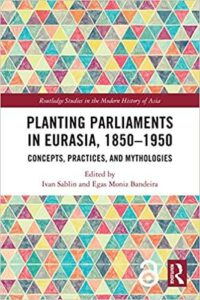Dear colleagues, it is our great pleasure to announce the publication of our book “Planting Parliaments in Eurasia, 1850–1950: Concepts, Practices and Mythologies” with Routledge. It is available in open access at the database of the publisher; the print version will follow in a few weeks.
 The full book can be found HERE
The full book can be found HERE
Individual chapters can be found HERE
Abstract:
Parliaments are often seen as Western European and North American institutions and their establishment in other parts of the world as a derivative and mostly defective process. This book challenges such Eurocentric visions by retracing the evolution of modern institutions of collective decision-making in Eurasia. Breaching the divide between different area studies, the book provides nine case studies covering the area between the eastern edge of Asia and Eastern Europe, including the former Russian, Ottoman, Qing, and Japanese Empires as well as their successor states. In particular, it explores the appeals to concepts of parliamentarism, deliberative decision-making, and constitutionalism; historical practices related to parliamentarism; and political mythologies across Eurasia. It focuses on the historical and “reestablished” institutions of decision-making, which consciously hark back to indigenous traditions and adapt them to the changing circumstances in imperial and postimperial contexts. Thereby, the book explains how representative institutions were needed for the establishment of modernized empires or postimperial states but at the same time offered a connection to the past.
Table of Contents
Introduction. By Ivan Sablin, Egas Bender Moniz Bandeira
1. Duma, yuan, and beyond: Conceptualizing parliaments and parliamentarism in and after the Russian and Qing Empires. By Ivan Sablin, Egas Bender Moniz Bandeira, Jargal Badagarov, Dorn Identität, Irina Bsodnams
2. Montesquieu vs. Bagehot: Two visions of parliamentarism in Japan. By Yuri Kono, translated by Egas Bender Moniz Bandeira.
3. Public opinion under imperial benevolence: Japanese “national essence” leader Torio Koyata’s anti-liberal parliamentarianism in the Genrō-in and the House of Lords. By Bruce Grover.
4. The assembly of the land (zemskii sobor): Historiographies and mythologies of a Russian “parliament”. By Ivan Sablin and Kuzma Kukushkin.
5. The 22 Frimaire of Yuan Shikai: Privy councils in the constitutional architectures of Japan and China, 1887–1917. By Egas Bender Moniz Bandeira.
6. A rada for the empire: Inventing the tradition of Cossack self-governance during the 1905 Revolution. By Alexander Polianichev.
7. Ottoman parliamentary procedure in the Chamber of Deputies (Meclis-i Mebusan) and the Great National Assembly of Turkey (Türkiye Büyük Millet Meclisi), 1876–1923. By Ellinor Morack.
8. Nominal democracy in Stalinism: The Soviet Constitution of 1936. By Olga Velikanova.
9. The preparations for the first Chinese People’s Political Consultative Conference and the quest for legitimacy. By Henrike Rudolph.

